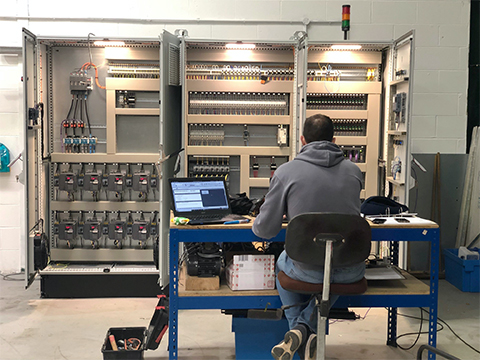
Posted to News on 4th Feb 2022, 14:32
Driving for more efficiency

The optimisation of energy usage by electric motors can lead to environmental benefits as well as reductions in operational expenses (OPEX). Forward-looking businesses interested in reducing their motors’ energy use can now go further than before, by implementing new tools that enable variable speed drives (VSDs) to save even more energy.
Wayne Turtill, product manager for VSD, servos and LVS at Mitsubishi Electric, looks at how to reduce energy usage even more with the right VSD technology.
VSDs have long been used in applications where varying motor output speeds are required, such as fans, pumps, winches, conveyors and varied production machines. By controlling the key elements of a motor’s electricity supply – namely voltage and frequency – VSDs can adjust the speed and torque to deliver the process requirements of the machine or device they are driving to a very precise level.
Using VSDs to reduce energy use makes a huge difference already, especially when compared to other solutions to adjust the output speed, for example dampers and valves or gears and pulleys. In effect, using a VSD to reduce motor speed from 100% to 80% in variable torque load applications can cut energy use by up to 50%. In constant torque systems, a 50% speed reduction typically results in 50% less power being consumed.
For a 22 kW motor driving a centrifugal pump for example, the potential annual energy savings resulting from the introduction of a VSD are estimated around 131,833kWh (application dependant). This can lead to a reduction of £11,865 in OPEX while preventing the emission of 69.1 tonnes of carbon dioxide. Looking at much larger motors; according to Gambica approximately 2000 new 75kW motors were installed between 2019 and 2020. Therefore, the total energy and cost savings can be extraordinary.
Moving beyond the usual VSD benefits
Installing VSDs to operate motors is a good starting point. Not only will this reduce energy consumption and associated costs but, when correctly applied, a VSD could also help improve the environmental impact of industrial activities.
It is common practice for companies using fan and pump loads to oversize their motors. Possible reasons for this are that the ideal motor size falls between standard frame sizes or it may have been specified one frame size up ‘just in case’. As a general recommendation, oversizing the fan or pump system and particularly the motor should be avoided. Instead, businesses should select products that meet the necessary specifications without exceeding them. It is however also recognised, that this is not always easy or practical to do so. While there are situations where it is not possible to avoid oversizing, suitably rated VSDs can still provide the correct level of control, enabling significant energy savings.
In particular, businesses that select VSDs with specific energy reduction capabilities have more to gain. For example, Mitsubishi Electric’s VSDs are equipped with an Automatic Energy Optimisation function, which can be easily switched on and off by end users. In basic terms, this feature analyses the output to the motor in terms of voltage and current, to reduce the voltage while maintaining the same operating parameters, ie speed. The voltage is reduced until the VSD detects an increase in the current. At this point, the voltage is increased to compensate. Ultimately, the solution uses a Proportional-Integral-Derivative (PID) algorithm without setpoints, allowing the system to reach the lowest (and most efficient) voltage possible.
These adjustments are conducted a hundred times per second, supporting real-time, continuous voltage control. Even more, the process occurs during steady state operations as well as acceleration and deceleration, providing an optimum curve for the motor. As a result, it is estimated that even systems that are running at full speed and are considerably oversized can experience energy savings of up to 12% by means of Mitsubishi Electric VSDs with their Automatic Energy Optimisation function.
Next-level energy intelligence
Finally, application-specific functions in next-generation Mitsubishi Electric VSDs can help businesses cut energy consumption even further when applied to certain applications, such as pumps, fans, winches and conveyors. Using Mitsubishi Electric’s E800 range of VSDs, featuring Advanced Magnetic Flux Vector control on a conveyor for example provides optimum dynamic performance. It can then automatically switch the VSD into energy saving mode when the conveyor is not loaded and maintains this efficient state until a load is applied. This leads to substantial energy savings compared to more conventional control methods.
Choosing the right equipment for motor-driven applications can therefore deliver significant cost and energy savings, far beyond what you would normally expect for a VSD application. By implementing state-of-the-art VSDs and using the full feature set available for that drive, businesses can reap the added efficiency gains while still benefitting from all the flexibility and productivity advantages of a traditional control philosophy.


















